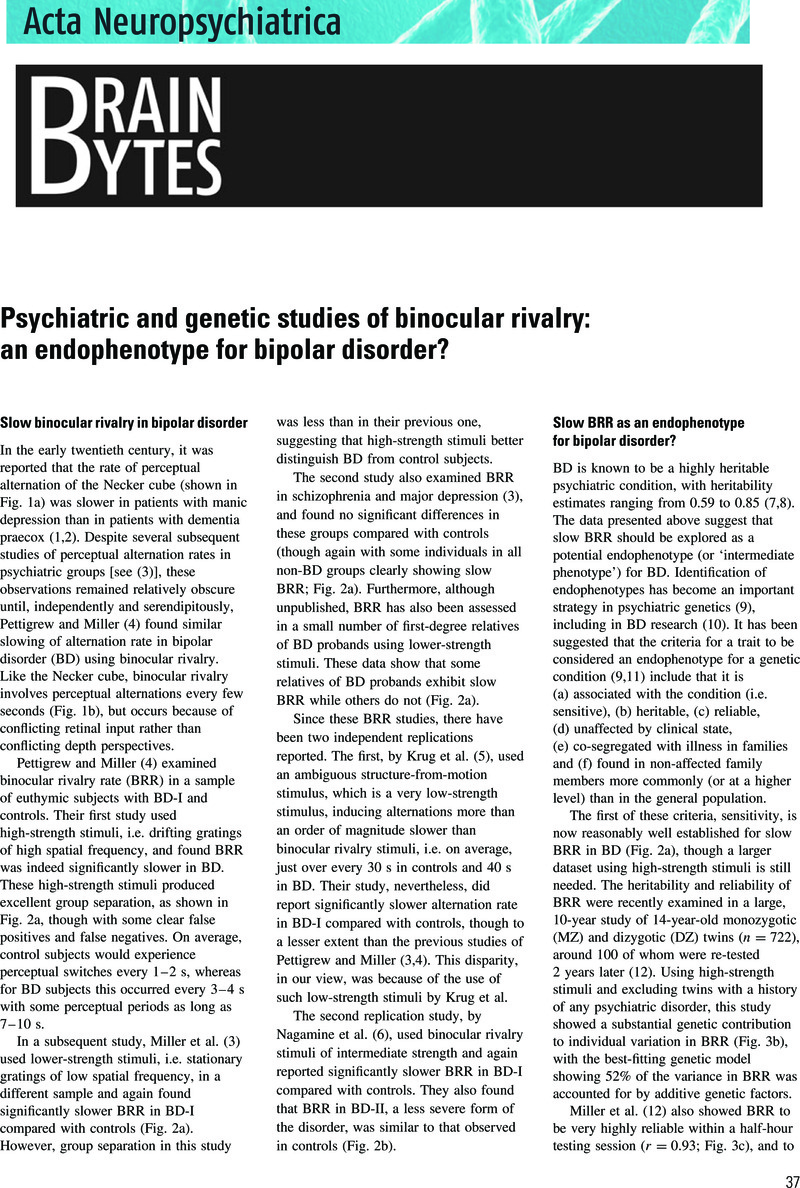Crossref Citations
This article has been cited by the following publications. This list is generated based on data provided by Crossref.
Vierck, Esther
Porter, Richard J
Luty, Sue E
Moor, Stephanie
Crowe, Marie T
Carter, Janet D
Inder, Maree L
and
Joyce, Peter R
2013.
Further evidence for slow binocular rivalry rate as a trait marker for bipolar disorder.
Australian & New Zealand Journal of Psychiatry,
Vol. 47,
Issue. 4,
p.
371.
Schmack, Katharina
Sekutowicz, Maria
Rössler, Hannes
Brandl, Eva J.
Müller, Daniel J.
and
Sterzer, Philipp
2013.
The influence of dopamine‐related genes on perceptual stability.
European Journal of Neuroscience,
Vol. 38,
Issue. 9,
p.
3378.
Law, Phillip C. F.
Paton, Bryan K.
Thomson, Richard H.
Liu, Guang B.
Miller, Steven M.
and
Ngo, Trung T.
2013.
Dichoptic Viewing Methods for Binocular Rivalry Research: Prospects for Large-Scale Clinical and Genetic Studies.
Twin Research and Human Genetics,
Vol. 16,
Issue. 6,
p.
1033.
Scocchia, Lisa
Valsecchi, Matteo
and
Triesch, Jochen
2014.
Top-down influences on ambiguous perception: the role of stable and transient states of the observer.
Frontiers in Human Neuroscience,
Vol. 8,
Issue. ,
Jia, Ting
Ye, Xing
Wei, Qiang
Xie, Wen
Cai, Chunlan
Mu, Jingjing
Dong, Yi
Hu, Panpan
Hu, Xinglong
Tian, Yanghua
and
Wang, Kai
2015.
Difference in the binocular rivalry rate between depressive episodes and remission.
Physiology & Behavior,
Vol. 151,
Issue. ,
p.
272.
Law, Phillip C. F.
Paton, Bryan K.
Riddiford, Jacqueline A.
Gurvich, Caroline T.
Ngo, Trung T.
and
Miller, Steven M.
2015.
No Relationship Between Binocular Rivalry Rate and Eye-Movement Profiles in Healthy Individuals: A Bayes Factor Analysis.
Perception,
Vol. 44,
Issue. 6,
p.
643.
Miller, Steven M
2016.
Vestibular neuromodulation: stimulating the neural crossroads of psychiatric illness.
Bipolar Disorders,
Vol. 18,
Issue. 6,
p.
539.
Law, Phillip C.F.
Miller, Steven M.
and
Ngo, Trung T.
2017.
The effect of stimulus strength on binocular rivalry rate in healthy individuals: Implications for genetic, clinical and individual differences studies.
Physiology & Behavior,
Vol. 181,
Issue. ,
p.
127.
Antinori, Anna
Smillie, Luke D.
and
Carter, Olivia L.
2017.
Personality Measures Link Slower Binocular Rivalry Switch Rates to Higher Levels of Self-Discipline.
Frontiers in Psychology,
Vol. 7,
Issue. ,
Law, Phillip CF
Gurvich, Caroline T
Ngo, Trung T
and
Miller, Steven M
2017.
Evidence that eye‐movement profiles do not explain slow binocular rivalry rate in bipolar disorder: support for a perceptual endophenotype.
Bipolar Disorders,
Vol. 19,
Issue. 6,
p.
465.
Chen, Biqing
Zhu, Zijian
Na, Ren
Fang, Wan
Zhang, Wenxia
Zhou, Qin
Zhou, Shanbi
Lei, Han
Huang, Ailong
Chen, Tingmei
Ni, Dongsheng
Gu, Yuping
Liu, Jianing
Fang, Fang
and
Rao, Yi
2018.
Genomic Analyses of Visual Cognition: Perceptual Rivalry and Top-Down Control.
The Journal of Neuroscience,
Vol. 38,
Issue. 45,
p.
9668.
Cao, Teng
Wang, Lan
Sun, Zhouyuan
Engel, Stephen A.
and
He, Sheng
2018.
The Independent and Shared Mechanisms of Intrinsic Brain Dynamics: Insights From Bistable Perception.
Frontiers in Psychology,
Vol. 9,
Issue. ,
Xiao, Guixian
He, Kongliang
Chen, Xingui
Wang, Lu
Bai, Xiaomeng
Gao, Liling
Zhu, Chunyan
and
Wang, Kai
2018.
Slow Binocular Rivalry as a Potential Endophenotype of Schizophrenia.
Frontiers in Neuroscience,
Vol. 12,
Issue. ,
Ye, Xing
Zhu, Ruo-Lin
Zhou, Xiao-Qin
He, Sheng
and
Wang, Kai
2019.
Slower and Less Variable Binocular Rivalry Rates in Patients With Bipolar Disorder, OCD, Major Depression, and Schizophrenia.
Frontiers in Neuroscience,
Vol. 13,
Issue. ,
Katyal, Sucharit
He, Sheng
He, Bin
and
Engel, Stephen A.
2019.
Frequency of alpha oscillation predicts individual differences in perceptual stability during binocular rivalry.
Human Brain Mapping,
Vol. 40,
Issue. 8,
p.
2422.
Miller, Steven M.
2020.
Fluctuations of consciousness, mood, and science: The interhemispheric switch and sticky switch models two decades on.
Journal of Comparative Neurology,
Vol. 528,
Issue. 17,
p.
3171.
Blake, Randolph
2022.
The Perceptual Magic of Binocular Rivalry.
Current Directions in Psychological Science,
Vol. 31,
Issue. 2,
p.
139.
Zhou, Liqin
Tang, Zhonghua
Zuo, Zhentao
and
Zhou, Ke
2022.
Neural Mechanism Underlying the Sleep Deprivation-Induced Abnormal Bistable Perception.
Cerebral Cortex,
Vol. 32,
Issue. 3,
p.
583.
Manyukhina, Viktoriya O.
Orekhova, Elena V.
Prokofyev, Andrey O.
Obukhova, Tatiana S.
Stroganova, Tatiana A.
and
Fernandes, Thiago P.
2022.
Altered visual cortex excitability in premenstrual dysphoric disorder: Evidence from magnetoencephalographic gamma oscillations and perceptual suppression.
PLOS ONE,
Vol. 17,
Issue. 12,
p.
e0279868.
Acquafredda, Miriam
Sarı, İzel D.
Steinwurzel, Cecilia
Lunghi, Claudia
and
Binda, Paola
2023.
Measuring the reliability of binocular rivalry.
Journal of Vision,
Vol. 23,
Issue. 10,
p.
5.





